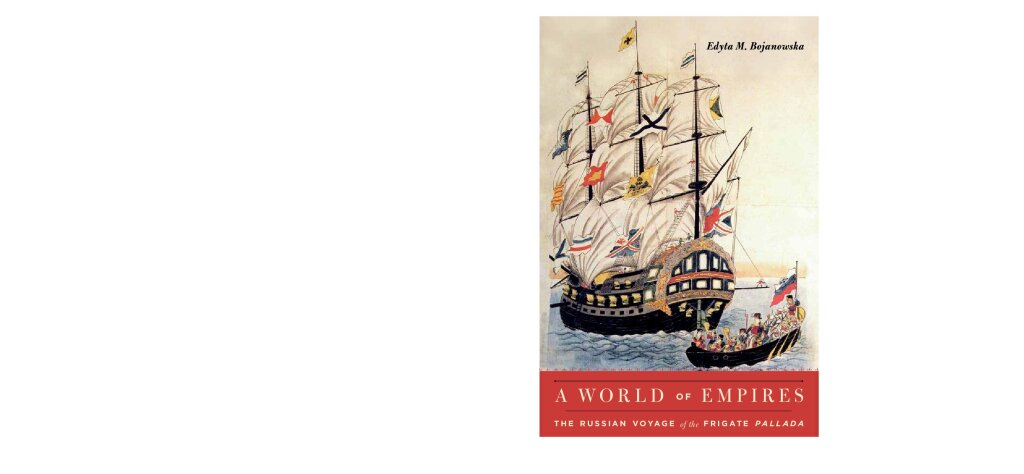On Monday, November 19th, the Jordan Center hosted “A World of Empires: The Russian Voyage of the Frigate Pallada”, a book talk with Edyta Bojanowska. Bojanowska is Professor of Slavic Languages and Literatures and Chair of the MacMillan Center’s European Studies Council at Yale University, and specializes in 19th century Russian literature and intellectual history. She is also the author of the prize-winning book “Nikolai Gogol: Between Ukrainian and Russian Nationalism”. The talk was introduced by Department Chair of NYU Russian & Slavic Studies Anne Lounsbery.
Bojanowska’s book examines a travelogue by Ivan Goncharov, better known as the author of the novel Oblomov, using his eyewitness account as a window onto imperial history of the 19th century and Russia’s perceptions of and relations with its own colonial subjects. Although excluded from the Russian literary canon, Goncharov’s Frigate Pallada was a bestseller in Russia for decades after its publication. Professor Bojanowska’s own approach to Goncharov’s work is interdisciplinary, drawing on historical theories of travel writing in its analysis of the text. Bojanowska stressed that the language she used in the book is accessible to a general audience.
The naval voyage took Goncharov, a “self-proclaimed Homer,” around Africa and Asia with the task of reaching Russia’s North American possessions: Alaska, and parts of California. The unofficial motive of the trip, however, was to establish trade relations with Japan. In 1852 the ship set sail from Kronstadt Island and made its way around the coast of Africa and through East Asia. Goncharov served as the secretary to the commodore, and kept an official record of the journey’s progress in addition to his own personal impressions. After the ship’s arrival to Korea, Goncharov travelled back to St. Petersburg by land through Russia’s Far East. The travelogue breaks off with Goncharov’s arrival in Irkutsk in 1853, 15 months after his departure. Five years later, the text was published in its entirety.
Bojanowska argued that the travelogue’s significance lies in the fact that “no other major 19th century Russian writer saw as much of the world as Goncharov”. She also characterized it as a great piece of Russian prose that achieved double the circulation of Oblomov. Goncharov himself characterized it as his “rose without thorns,” and the travelogue became a model for all subsequent Russian travel writing, inspiring the likes of Chekhov, Nabokov, and even Leonid Brezhnev. It was studied in schools and military academies and read by government officials, making it the third most-read text in Russian history. In her own book, Bojanowska explains the travelogue’s failure to achieve canonization as a result of its uncertain position between fiction and non-fiction, and its partial censorship in the Soviet Union.
Despite being drastically different from Oblomov, the travelogue, according to Bojanowska, “places the novel’s ‘Russian questions within the global worldview of its creator”, while “providing a powerful deterrent to nostalgic readings of ‘Oblomov’”. “Frigate Pallada” transformed “Oblomov's” hero Stultz into “the type of hero that the modernizing empire really needs.” Quoting Professor Lounsbery’s interpretation of Oblomov, which characterizes the novel as an expression of Russia’s need “to get connected intellectually, economically, and spatially”, Bojanowska said that both texts are consistent. In order to accelerate its modernization and imperial ambitions, the Russian Empire needed a book like the “Frigate Pallada”. Bojanowska’s own book uses this text to illustrate the fact that the Russian Empire acted on the global stage, an important task because “Russia remains marginalized from the global imperial historical narrative.” Bojanowska portrays Russia in the 19th century as an “increasingly assertive empire that understood itself and operated diplomatically and effectively based on trade and imperial expansion”.
Imperialism, colonialism and race are the primary topics that interested Bojanowska in her analysis. Goncharov’s account, Bojanowska argued, was not a collection of mere impressions, as it made bold ideological and polemic claims, championing Russia’s colonial activity “as hallmarks of modernity and global capitalism”, and promoting Russia’s civilizing mission. “Russia must catch up to its colonial rivals, especially the British,” was the main message echoed in the the halls of Russia’s palaces. According to Bojanowska, the Frigate Pallada’s crew was much less racist than its American counterpart. Nevertheless, violent means of “civilizating” colonized peoples didn’t seem to bother Goncharov, and the writer maintained a strong eurocentric tone. The text should therefore not be characterized as anti-colonial, Bojanowska argued. Goncharov never refrains from from stereotyping, and continuously slots his subjects into eurocentric hierarchies. But the account should likewise not be reduced to an “overzealous service to political authorities”. Most importantly, despite its eyewitness quality, the text shouldn’t be read as a transparent and empirical window into the world Goncharov observes.
Throughout each chapter of her book, Bojanowska identifies a key problem in the images Goncharov painted of the locations he visited. The first chapter examines Goncharov’s earlier visits to London and its Cape Town colony, and establishes Goncharov’s penchant for imperial comparisons. The comparative theme continues to run throughout the entire book: in Cape Town, Goncharov muses on how empires maintain control over indigenous populations from afar; in Asia, Goncharov expresses his appreciation for tariffs, while marvelling at port towns in their ability to establish a global network. Goncharov found himself in China during the Taipei Rebellion, to which he responded with a denouncement of the immorality of Britain’s Opium trade. Upon his visit to Japan, Goncharov became gripped by grandiose visions of remaking Japan into a fully westernized culture, attracted by its fertile land and seeing it as a crucial target for Russia’s imperial expansion. Bojanowska also brought attention to another episode detailing Russia’s interaction with Japan, though it is not described in Goncharov’s book. In 1854, following a devastating tsunami that hit Japan’s coast, the Russian ship crew of Admiral Yevgeny Putyatin and Japanese local communities helped one another in their recovery from from the catastrophe.
Upon his arrival to Siberia, Goncharov explored the potential of a “Russian manifest destiny of colonial expansion”, praising the Russian Orthodox mission in converting and Russifiying the indegenous peoples. In the fifth chapter of her book, Bojanowska outlines Goncharov’s conceptual grid of race, nationality, ethnicities. Goncharov’s perception of others intertwined with questions of how Russians can occupy these exotic settings permeate the text. Goncharov characterized Siberia “as Russia’s civilizing miracle to rival the Western model,” but couldn’t fathom how certain Russians chose to adopt Siberian cultures. In the final segment of her book, Bojanowska focuses on how Goncharov’s text was made palatable for the Soviet regime. The text was condensed and the racist points were omitted, making “key portions of the travelogue vanish into thin air”. Bojanowska concluded her talk by describing the result of the Frigate Pallada’s journey: a diplomatic “tango” with Japanese officials that culminated in the Treaty of Saint Petersburg.



